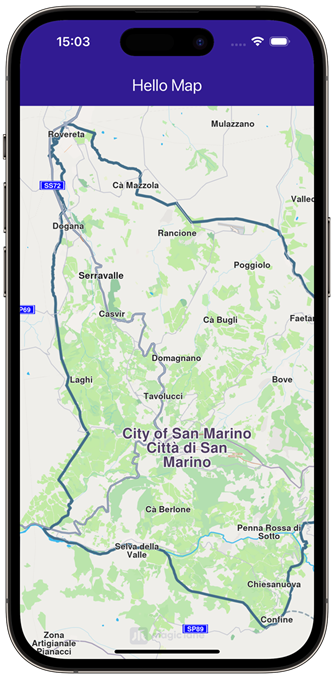Get started with maps
The Maps SDK for Flutter delivers powerful mapping capabilities, enabling developers to effortlessly integrate dynamic map views into their applications. Core features include embedding and customizing map views, controlling displayed locations, and fine-tuning map properties. At the center of the mapping API is the GemMap, a subclass of StatefulWidget, offering a wide range of configurable options.
Display a map
The following code demonstrates how to show a map view. This is the main.dart file.
import 'package:flutter/material.dart';
import 'package:gem_kit/core.dart';
import 'package:gem_kit/map.dart';
const projectApiToken = String.fromEnvironment('GEM_TOKEN');
void main() {
runApp(const MyApp());
}
class MyApp extends StatelessWidget {
const MyApp({super.key});
Widget build(BuildContext context) {
return const MaterialApp(
debugShowCheckedModeBanner: false,
title: 'Hello Map',
home: MyHomePage(),
);
}
}
class MyHomePage extends StatefulWidget {
const MyHomePage({super.key});
State<MyHomePage> createState() => _MyHomePageState();
}
class _MyHomePageState extends State<MyHomePage> {
void dispose() {
GemKit.release();
super.dispose();
}
Widget build(BuildContext context) {
return Scaffold(
appBar: AppBar(
backgroundColor: Colors.deepPurple[900],
title: const Text('Hello Map', style: TextStyle(color: Colors.white)),
),
body: const GemMap(
appAuthorization: projectApiToken,
onMapCreated: _onMapCreated,
),
);
}
void _onMapCreated(GemMapController mapController) {
// Code executed when the map is initialized
}
}
 |
|---|
| Displaying a default day map |
The GemMap widget includes a callback, onMapCreated, which is triggered once the map has finished initializing. It also provides a GemMapController to enable additional map functionalities.
const GemMap(
appAuthorization: projectApiToken,
onMapCreated: _onMapCreated,
),
Multiple GemMap widgets can be instantiated within a single application, allowing for the display of different data on each map. Each GemMap is independently controlled via its respective GemMapController.
Note that certain settings, such as language, overlay visibility, and position tracking, are shared across all GemMap instances within the application.
When the GemMap is destroyed the GemMapController object is disposed. Calling methods on the disposed GemMapController object or on associated objects (such as MapViewPreferences, FollowPositionPreferences, LandmarkStoreCollection, etc. ) is not supported and may crash the app.
Set the SDK language
To configure the SDK's language, select a language from the SdkSettings.languageList getter and assign it using the SdkSettings.language setter.
Language? engLang = SdkSettings.languageList.where((lang) => lang.languagecode == 'eng').first;
SdkSettings.language = engLang;
The languagecode follows the ISO 639-3 standard. Multiple variants may exist for a single language code. Further filtering can be applied using the regionCode field within the Language object, which adheres to the ISO 3166-1 standard.
This operation modifies the language used for search results, category names, instructions, and all texts returned by the SDK.
The language of the TTS instructions is different from the SDK language and it can be set using the SdkSettings.setTTSLanguage method. More details can be found inside the voice guidance guide.
To ensure the map uses the same language all over the world, use the following code:
SdkSettings.mapLanguage = MapLanguage.automatic;
To show location names in their native language (where available) for the respective region, use this code:
SdkSettings.mapLanguage = MapLanguage.native;